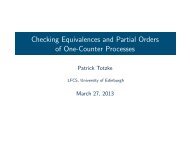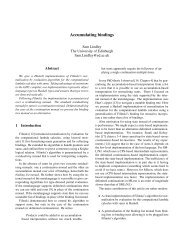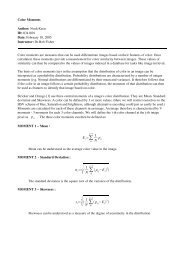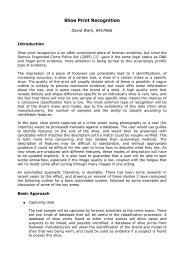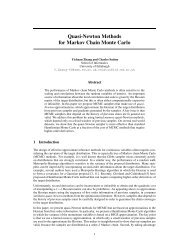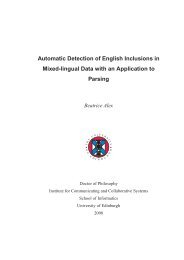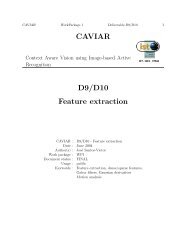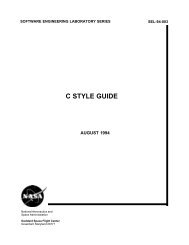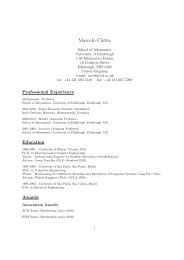Continuous Truth I Non-constructive Objects
Continuous Truth I Non-constructive Objects
Continuous Truth I Non-constructive Objects
Create successful ePaper yourself
Turn your PDF publications into a flip-book with our unique Google optimized e-Paper software.
LOGIC COLLOQUIUM '82<br />
G. Lalli, G. Long0 and A. 'Marcia (editors)<br />
0 Elsevier Science Publishers B. V. (North-Holland), 1984 161<br />
CONTINUOUS TRUTH I<br />
<strong>Non</strong>-<strong>constructive</strong> <strong>Objects</strong><br />
Michael P. Fourman<br />
Department of Mathematics<br />
Department of Pure Mathematics<br />
Columbia University<br />
Uni vers i ty of Sydney<br />
New York, N.Y. 10027 N.S.W. 2006<br />
U.S.A.<br />
Australia<br />
We give a general theory of the logic of potentially<br />
infinite objects, derived from a theory of meaning for<br />
statements concerning these objects. The paper has two<br />
main parts which may be read independently but are<br />
intended to complement each other. The first part is<br />
essentially philosophical. In it, we discuss the theory<br />
of meaning. We believe that even the staunchest realist<br />
must view potential infinities operationally. The second<br />
part is formal. In it, we consider the interpretation of<br />
logic in the gros topos of sheaves over the category of<br />
separable locales equipped with the open cover topology.<br />
We show that general principles of continuity, local<br />
choice and local compactness hold for these models. We<br />
conclude with a brief discussion of the philosophical<br />
significance of our formal results. They allow us to<br />
reconc!le our explanation of meaning with the "equivalence<br />
thesis , that 'snow is white is true' iff snow is white.<br />
PROLEGOMENON<br />
Classical mathematics is based on a platonic view of mathematical objects. The<br />
meanings of mathematical statements are determined truth-functionally. This<br />
Fregean explanation of meaning justifies classical logic. The deficiencies of<br />
such a view are amply discussed by Dummett C19781.<br />
A <strong>constructive</strong> mathematician rejects the completed infinities of classiGa1 mathematics.<br />
For him, the objects of mathematics are essentially finite. The meaning<br />
of quantification over infinite domains is given operationally in terms of a<br />
theory of constructions. The resulting logic includes Heyting's predicate calculus<br />
and other principles (e.g. choice principles).<br />
As Dummett has stressed, one task of any philosophy of mathematics is to explain<br />
the applicability of mathematics. The potential infinities of experience exceed<br />
the finite objects of the strict constructivist. They demanda mathematics of infinite<br />
objects. Naive abstraction leads to the ideal infinite objects of classical<br />
mathematics. This idealisation has enjoyed remarkable success. However,<br />
the meaning of statements .of classical mathematics remains problematic.<br />
Brouwer C19811 introduced to mathematics potentially infinite objects such as freechoice<br />
sequences. Consideration of these justified, for Brouwer, intuitionistic<br />
logic, including various choice and continuity princip2e.s. We shall consider a<br />
general notion of non-<strong>constructive</strong> object. For us, to present such a notion is to<br />
give a theory of meaning for statements involving non-<strong>constructive</strong> objects.<br />
Our non-<strong>constructive</strong> objects are not the platonic ideal objects of classical<br />
mathematics nor the finitary objects of pure constructivism. They are potentially
162 M.P. FOURMAN<br />
infinite objects related to the lawless sequences of Kreisel 119681and to Brouwer's<br />
free-choice sequences (Troelstra 119771). The meanin s of statements about these<br />
objects cannot be given in terms of truth conditions ?as for classical Platonist<br />
mathematics) or in terms of constructions (as for naive constructivism). The<br />
essence of these non-<strong>constructive</strong> objects lies in their infinite character. They<br />
are not, in general, totally grasped. They are given in terms of partial data<br />
which may later be refined. Meaning for statements about non-<strong>constructive</strong> objects<br />
is given by saying what data justifies a given assertion.<br />
To describe a particular notion of non-<strong>constructive</strong> object is to describe the type<br />
of data on which it is based. We consider various such notions. Each conception<br />
of data gives an explanation of meaning which extends the range of meaningful<br />
statements and may be viewed as introducing new objects in that it ascribes meaning<br />
to new forms of quantification. In fact for each type of data we introduce a<br />
concrete representation of the non-<strong>constructive</strong> objects based on it.<br />
Such a project is not novel: Beth 119471 introduced his models to provide just<br />
such an explanation of meaning for choice sequences. Our models generalise Beth's.<br />
Dumnett 119771 makes a lengthy critique of the view that the intended meanings of<br />
of the logical constants are faithfully represented on Beth trees. Since our<br />
models generalise Beth's they appear prima facie to be susceptible to the same<br />
criticisms. However, Dummett's remarks on the (non)-consonance of the intended<br />
meanings of the connectives with their interpretation in Beth trees are directed<br />
at a different problem from the one we address. Dummett appears to have oierlooked<br />
the possibility of separating the problem of explaining the <strong>constructive</strong> meaning<br />
of statements concerning lawlike objects from that of explaining the intuitionistic<br />
meaning of statements concerning choice sequences. Although we know of no<br />
satisfactory explanation of <strong>constructive</strong> truth (in particular, we agree with<br />
Dummett that Beth models do not give one), such a separation appears natural. It<br />
is possible to conceive of <strong>constructive</strong> truth independently of choice sequences.<br />
Given such a conception, Beth models provide an account of the introduction of<br />
non-lawlike objects. It is this type of account we have generalised. By way of<br />
example we now consider two notions of data closely related to Beth models. They<br />
both arise from the same informal picture.<br />
Imagine receiving from Mars an infinite sequence a of natural numbers. The<br />
picture is of a ticker-tape which produces an indefinitely continued finite<br />
initial segment a of the sequence CL. (We write CL E a to mean that a is an initial<br />
segment of a.) We want to examine the consequences of treating such undetermined<br />
sequences seriously as sequences. (Later we shall introduce more interesting<br />
examples .)<br />
A naive view of this example considers the stages by which information arises:<br />
at any stage, the possible future data is represented by the collection N
<strong>Continuous</strong> <strong>Truth</strong> I 163<br />
and<br />
inductive<br />
a* lt $ for all n E N<br />
alk @<br />
Persistence reflects the idea that knowledge, once justified, is secure. The inductive<br />
clause comes from reflection on the infinite character of a. Given a E a,<br />
the collection {a* I nc NI covers all possibilities for future data.<br />
In general, if we stipulate blk $ for b E B 5 N
164 M.P. FOURMAN<br />
forming one such process into another, generally less free: its restriction.<br />
We give a general definition of this transformation as follows:<br />
clk $(sib) iff b*clk $(6)<br />
(Where 6 is a non-<strong>constructive</strong> object given by stipulating what data justifies<br />
$(6) for various $.)<br />
For example, alb = a' = a; Olb = a'; ylb = y'.<br />
This change of viewpoint amount sformally to a change in our representation of data.<br />
Formerly we considered the partially ordered set or tree N
<strong>Continuous</strong> <strong>Truth</strong> I 165<br />
top element T). The poset IP is equipped with a notion of covering family. We<br />
demand that this be<br />
ref Zective<br />
stabZe<br />
ip} covers p<br />
If U covers p and q 5 p then Iq A w I w E Ul covers q<br />
monotone If V 2 U covers p then V covers p.<br />
The notion of a covering family is crucial to our explanation of meaning for incomplete<br />
objects. It formalises the sense in which they are potentially infinite.<br />
We avoid the metaphor of Wright C19811 which represents such a covering family as<br />
embodying the recognition that the state of information is capable of effective<br />
enlargement to one of type a* because it seems to leave open to us the choice<br />
of not performing this enlargement. The idea we have is to introduce consideration<br />
of a particular type of incomplete object by specifying the type of data which<br />
generates it. This specification includes a notion of covering family. Differences<br />
over which is the proper collection of covering families do not affect the<br />
basic conception but merely lead to different types of data.<br />
We are not as mathematicians or logicians interested in the result of a particular<br />
experiment. Rather, we are interested in those properties which would remain invariant<br />
no matter what the outcome or methodology of a particular experiment. It<br />
is not the result but the uses to which the result might be put in defining mathematical<br />
quantities which interest us. Were the temperature scale non-linear,or<br />
the time scale given by the unequal time of the sun, physics would be different<br />
(it was). But mathematics and logic should be immune to such vagaries.<br />
Our solution is similar to that we employed in giving an objective view of. open<br />
data. The possibility we envisage is that of a change of scale which in some<br />
sense refines our possibilities for measurement. The measurements of the old context<br />
should be meaningful in the new one but the new one may afford finer distinctions.<br />
To describe such a change of scale is to say which new observations q E Q<br />
are to be viewed as refining an old observation p E IP. We write this relation<br />
q 5 f*(p) and demand that it be<br />
monotone<br />
p 5 p'<br />
muZtip Zicative q 5 f*(p) q 5 f*(p')<br />
q 5 f*(p A p')<br />
continuous<br />
pi I i E I covers p r 5 f*(p)<br />
{q I q f*(pi) some i E 11 covers r .<br />
The motivation for the first two is clear. Continuity may be viewed as the requirement<br />
that a previous conviction that a certain family covers, cannot be overturned.<br />
The change of viewpoint induced by such a transformation f is given by<br />
Mathematically, our notion of data gives a presentation of a ZocaZe. Change of<br />
scale is represented by a continuous function between locales. Abstractly we<br />
write such a change f: Y -f X.<br />
We now consider a supplement to our notion of justification. Suppose, we consider,<br />
that consideration of a particular type of data would justify 0, then C$ is justified.<br />
This is the reflection on which our whole project is based: that we can<br />
justify talk of incomplete objects by reflecting on hypothetica2 indefinitely<br />
continued processes.
166 M.P. FOURMAN<br />
We shall formulate this by saying that if f: Y + X represents the introduction of<br />
new distinctions independent of those represented by X then<br />
or that such an f is a cover.<br />
Our final problem of formalisation is to characterise the introduction of<br />
independent data. A simple example is, given Pand Q with notions of covering, to<br />
consider P x Q the product poset with coverings<br />
I I i E I1 covers p.q when {pi 1 i E I} covers p<br />
I I i E I} covers p,q when qi 1 i E I} covers q.<br />
The projection given by 5 n*(p') iff p s p' represents the introduction of<br />
data of type Q independently of the data IP under consideration. We shall require<br />
that all such projections be covers.<br />
In general there are two conditions we require to view a change of scale as the<br />
introduction of independent data. The first is obvious: no new covers should be<br />
introduced between existing observations.<br />
qi s f*(ri) {qi 1 i E I} covers each q 5 f*(r)<br />
{ri I i E I} covers r<br />
The second is subtle: no new conditional relationships should be introduced between<br />
existing observations. We explain: if w E Q is such that<br />
r 5 f*(p) r 5 w<br />
r 5 f*(q)<br />
(we view w as establishing a conditional relationship between f*(p) and f*(q)),<br />
we demand that w 5 f*(s) for some s E IP such that<br />
r s p r s s<br />
r s q<br />
(that the relationship be already established in IP). Technically, these requirements<br />
amount to demanding that the continuous map f: Y + X be a surjection and<br />
that it be open. The structure of data we have arrived at may be viewed as the<br />
category of locales equipped with the topology of covering by open maps.<br />
Before turning to a formal examination of the interpretation of logic over this<br />
site, we sum up our intentions.<br />
We introduce non-<strong>constructive</strong> objects by explaining the meanings of the connectives<br />
for statements concerning them. This is not a matter of characterising a<br />
domain of quantification. We have to explain the connectives anew in terms of<br />
the way such an object is given to us. Moreover, it is not sufficient to merely<br />
paraphrase the new quantifiers Wa and 3u. Such a paraphrase entails a revision<br />
of the interpretations of -+ and v.<br />
Our aim is to show that it is possible to derive rigorously properties of various<br />
domains of incomplete objects by giving a formal representation of the data which<br />
presents them as a site. We consider that the passage from an informal notion of<br />
data to the corresponding site is simple and natural. (Indeed, for us, to have a<br />
clear conception of a type of data is to be able to describe the corresponding<br />
site.) Once this passage is made, the derivation of properties (choice and continuity<br />
principles, for example) is a mathematical matter. Our hope in presenting<br />
these modeis is Leibnitzian: to eliminate further discussion of the justification<br />
of such principles by reducing the matter to calculation.<br />
In our paper "Notions of Choice Sequence" C19821 we presented various notions of
<strong>Continuous</strong> <strong>Truth</strong> I 167<br />
choice sequence, including ones satisfying the axioms of LS and CS, with the same<br />
purpose. Unfortunately, as the literature on choice sequences makes clear, clarity<br />
is in the eye of the beholder. Hence the present attempt at a more careful explanation<br />
of our informal notion of non-<strong>constructive</strong> object and its formalisation.<br />
CONTINUOUS TRUTH<br />
We start with a concrete presentation of the interpretation of higher-order logic<br />
in a Grothendieck topos. This material (561-3) is well-known to cognoscenti<br />
( tautologously), but is otherwise accessible only through a study of scattered<br />
references. We give some of these sources but make no systematic attempt at a<br />
complete list. Many important and historically significant contributions are not<br />
mentioned. Our account is fuller than is logically necessary for the sequel in<br />
order to point out some connections between different approaches. It is not, however,<br />
exhaustive.<br />
51 Frames and Locales<br />
1.1 Definition. A frame is a complete lattice with finite A distributive over<br />
arbitrary V. Frame morphisms, "and-or maps", are maps preserving these operations;<br />
T,A,V.<br />
1.2 Example. The lattice O(X) of open subsets of a topological space is a frame.<br />
If f: Y + X is a continuous map then the inverse image f*: O(X) -r O(Y) is an<br />
A,V-map.<br />
1.3 Definition. The category of Zocalos or generalised spaces is the dual of the<br />
category of frames. We call the morphisms continuous maps f: Y + X and write<br />
f*: U(X) + O(Y) for the corresponding inverse image maps between the frames of<br />
opens of X and Y (as in the topological case).<br />
Example 1.2 gives a functor 6: Top + LOC from topological spaces and continuous<br />
maps to locales.<br />
1.4 Discrete spaces.<br />
Spatially P(A) corresponds to the discrete topology on A.<br />
point space with O( ll) = P( ll) .<br />
An example is the one-<br />
1.5 Definition. A topological space X is sober iff Top[Il,Xl 1 LocCll,pX1.<br />
1.6 Lemma. On the full subcategory of sober spaces 6 is full and faithful.<br />
We tacitly restrict our attention to sober spaces and henceforth omit mention of 8.<br />
We view locales as generalised spaces. (The relationship between LOC and Top is<br />
better expressed in terms of the right adjoint, pt: LOC + Top, to 6.)<br />
, Quotient maps of frames induce congruences: if f*: O(X) + U(Y) is<br />
p a q iff f*p = f*q. Each congruence class !PI has a canonical<br />
representative jp = Vtq I p a q}. The maps j: O(X) + O(X) arising in this way are<br />
monotone<br />
idempotent<br />
muttip licative<br />
P 2 jp<br />
j2 = j<br />
j(p A 9) = jp A jq .<br />
Such maps are called nuctei. The quotient may be identified as the image (or<br />
fixed points) of j. The quotients of O(X) are isomorphic (as posets) with the<br />
nuclei on U(X). Spatially we view these quotients as giving rise to subspaces<br />
of x.
168 M.P. FOURMAN<br />
1.8 Surjections. Dually, we view injective inverse image maps as giving rise<br />
to surjections of spaces.<br />
1.9 Right adjoints.<br />
given by<br />
The map q<br />
p A<br />
where p + r = v!q I p A q 2 r}.<br />
morphisms are different).<br />
Each frame map f* has a right adjoint f,, direct image,<br />
=<br />
V{q 1 f*q 5 pl .<br />
f*p<br />
q has a right adjoint r + p -f r defined by<br />
p ~ q s r iff qsp+r<br />
Thus frames are complete Heyting algebras (but the<br />
1.10 Definition. A map of spaces f: X -f Y is o en if the inverse image map<br />
f*: O(y) + O(X) has a left adjoint 3,: U(X) + O(V7 commuting with A:<br />
3f(f*(Y) A x) = Y A jf(X)<br />
or, equivalently, if f* preserves +.<br />
1.11 Proposition. The category of locales is complete and cocomplete. Open<br />
surjections are stable (under pull-back).<br />
The theory of locales is developed extensively by Joyal and Tierney C19821.<br />
Johnstone 119821 uses locales systematically and has a comprehensive bibliography.<br />
52 Sites and Sheaves<br />
2.1 Definitions. Let 0 be a small categor . A cribte K of A E !El is a suboil<br />
functor of the representable functor A E S' : that is, for each B E 181 a set<br />
K(B) 5 IB,AI, stable under composition; for each f E K(B) and g: C -f B in C, the<br />
composite f 0 g E K(C).<br />
2.2 Lemma. The cribles of A form a frame, P(A).<br />
If f: B + A in B we have an inverse image map f*: P(A) + P(B) given by<br />
f*K = Ig f 0 g E K} for K E P(A). By abuse we write f: B -f A for the corresponding<br />
continuous map. This map is open.<br />
2.3 Definition. (Lawvere-Tierney) A Grothendieck topology j on is a<br />
family of nuclei jA: P(A) -f P(A), natural in A: that is f*o jA= jBof*for f: B + A.<br />
2.4 Lemma. If j is a Grothendieck topology on 0, the quotient frames n(A) have<br />
induced inverse image maps f*: n(A) + n(B) and the corresponding map of locales,<br />
which we write f: Bj +A', is open.<br />
2.5 Definitions.<br />
which is<br />
A pretopotogy J on 0 i s a family J(A) c P(A) for each A E<br />
reflerrive A E J(A)<br />
multiplicative<br />
K E J(A) L E J(A)<br />
K n L E J(A)<br />
B<br />
stable<br />
K E J(A) f: B + A<br />
f*K E J(B)<br />
(For example, let K E J(A) iff j K = T).<br />
A crible K E P(A) is inductively ctosed for J iff
<strong>Continuous</strong> <strong>Truth</strong> I 169<br />
f: B + A f*K E J(B) .<br />
f c K<br />
As A is closed and an intersection of closed cribles is closed, each crible<br />
K E P(A) has a cZosure jAK. This gives a topology j on C. We say K inductiveZy<br />
covers A iff j K = A, and write this K E J(A).<br />
___R_<br />
2.6 Exam les. (1) Let U(X) be a frame viewed as a poset viewed as a category.<br />
Let K E J A iff VK = A. (Identifying B + A with its domain.) Then n(X) 1 O(X).<br />
(2) Let be a small category of locales closed under finite limits and open<br />
inclusions. Let K E J(A) iff K contains some family Ifi: Bi + Ali E 11 of open<br />
maps such that V 3fi(Bi) = A.<br />
is closed for this topology. This assignment gives an A;V map r*: U(A) + n(A),<br />
spatially a surjection r: AJ + A. Each closed crible contains a largest open<br />
inclusion. This assignment gives an A V map i*: n(A) + U(A), spatially we have<br />
an inclusion i: A c+JJ. Furthermore, r o i = idA and r*i* s id,(A) so A is an<br />
adjoint retract of AJ (Fourman C19821).<br />
2.7 Definition. A presheaf on C is a functor X: Cop + Sets. If f: B + A E C and<br />
a E X(A) we use the notation alf, "a restricted along f", for X(f)(a) E X(B).<br />
Note that alflg = alfo g and alid = a. The appropriate morpkisms between presheaves<br />
F: Y + X are natural transformations, maps FA: Y(A) + X(A) which commute<br />
with restrictions FB(a,lf) = (FAa)lf.<br />
2.8 Exam les. (1) The representable functor [-,A], (or by abuse, justified by<br />
Yone a s emma, A) is a presheaf. Restrictions are by composition glf = gof.<br />
Yoneda's lemma tells us that for any other presheaf, X, we have X(A) [A,X]. In<br />
-7++<br />
The crible generated by each open inclusion U 4 A<br />
particular the embedding C + Stop is full and faithful. Each crible K E P(A) is a<br />
subpresheaf K H A.<br />
(2) P and n are presheaves with restrictions given by inverse images Klf = f*(K).<br />
2.9 Definition. A presheaf X on C is a sheaf for the (pre) topology J if whenever<br />
K E J(A), each natural transformation x: K + X has a unique extension along<br />
K >+ A. Equivalent1 y, if K E J(A) and we have a family xf E X(B) for f: B -f A E K<br />
such that xgf = xflg for each g: C + 8, there is a unique x E<br />
xf = xlf for each f E K.<br />
Grothendieck topos.<br />
X(A) such that<br />
The cateaorv of sheaves and natural transformations is a<br />
There is, as yet, no staisfactory introductory text on topos theory.<br />
references are SGA4, Wraith C19751, Johnstone C19771, Freyd '19721.<br />
The basic<br />
53 Forcing over a site<br />
Here we describe Joyal's presentation of interpretations in topoi in terms of a<br />
notion of forcing. Let C and a (pre) topology J be fixed. The basic structures<br />
we consider are diagrams<br />
-<br />
of preskeaves on C. Each presheaf A interprets a type<br />
or sort of variable. A morphism f: A1 x ... x An + B interprets an n-ary operation.<br />
A subobject R A1 x ... x An interprets an n-ary relation.<br />
3.1 Definitions. Let L be a first-order language (possibly many-sorted) with<br />
equality. An interpretation of L is given by assigning to each sort A of L a<br />
presheaf A, to each operation F from A1,. . .,An to B a natural transformation<br />
F: A1 x ... x An + B, and to each relation R on A1 x ... x An a subfunctor<br />
R * A1 x .. . x An.<br />
Given such an interpretation, for U E JCCJ we let LU be the
$<br />
170 M.P. FOURMAN<br />
expansion of L obtained by adding constants of the appropriate sorts for the elements<br />
of A(U). If f: V + U then for any term T or formula Q of LU we obtain a<br />
term T l f or formula @If of LV by restricting any new constants which occur.<br />
for U E IC1 we define for each closed term T of sort A of LU an interpretation<br />
[lTnu E A(U) by induction:<br />
Note that UTlfl" = [TDulf.<br />
for 4 a sentence of Lu.<br />
ucnu = c for c E A(U)<br />
[IF( TI,. . . ,Tn) 1,<br />
= F(lT,n,. . . ,iTnj) .<br />
Now we define inductively the relation, U forces Q,<br />
UIk Q<br />
Now<br />
INDUCTIVE DEFINITION OF FORCING<br />
V f l t @If all f: Vf<br />
UIt @<br />
+ K<br />
K E<br />
J(U)<br />
for all f: V + U, if VIE $If then V l t $If<br />
V l t @ +<br />
for all f: V + U, for all c E A(U), VIE ~lfCc/xl<br />
U l t wx.+<br />
We now give some "derived rules" for forcing:<br />
3.2 Lemma. Basic properties of forcing<br />
(PI<br />
U I t 0 f : V + U<br />
V l t +If
<strong>Continuous</strong> <strong>Truth</strong> I 171<br />
for each f in some K E<br />
UIt $ y Ji<br />
J(U) either Vflt$4f or V f l t $ l f<br />
Ult- 3x.g<br />
for each f in some K E j(U) we have V f l t $Cc/xl for some c E A(Vf)<br />
V l t 8 * +<br />
for all f: V + U if V l t glf then VIE +If<br />
VIE WX.$<br />
for all f: V -f U and all c E A(U), we have Vlk $lf[c/xl<br />
(Atomic)-<br />
for each f in some K E j(U)'we hav; E R(Vf)<br />
Our presentation here is non-standard in that the definition of forcing is usually<br />
given by stipulating both positive and negative rules for each connective, (I) and<br />
(P) are then derived. The resulting relation is the same.<br />
3.3 Definition. A sequent r - is<br />
pretation iff<br />
uaZid (written r 1 $) in the given inter-<br />
UI~$CS(X)/XI all q E<br />
u I t $CS(X)/Xl<br />
where E is an interpreation of the variables of L by elements of the appropriate<br />
A(U).<br />
3.4 Proposition. If each sort is interpreted by an inhabited presheaf (each<br />
A(U) is inhabited) then the axioms and rules of Heyting's propositional calculus<br />
are valid for k.<br />
(Adaptations for domains which are not inhabited are discussed in Fourman r19771,<br />
Scott 119781, Joyal & Boileau C19811, Makkai & Reyes 119771.)<br />
3.5 Definitions. A presheaf A is separated iff<br />
'Ita =<br />
a = b<br />
A subobject R t+ A is cZosed iff<br />
for a,b<br />
r<br />
E A(U)<br />
U I t R(a) for a E A(U).<br />
FaquJ<br />
A higher-order type-theory is merely a many-sorted first-order theory with some<br />
structure on the collection of sorts and certain distinguished operations and<br />
relations. One of the insights due to Lawvere and Tierney is that topoi have<br />
such higher-order structure. We consider languages where for any two sorts A and<br />
B we can form the product A x B with appropriate pairing and projection operations,<br />
the function space BA with an evaluation operation -( -), and also the power type
172 M.P. FOURMAN<br />
P(A) with a membership reZation E . An interpretation is standard if all this<br />
structure is interpreted by the corresponding structure on Sh((C).<br />
3.6 Proposition. In any standard interpretation the following schemata, which<br />
combine comprehension and extensionality, are valid.<br />
A<br />
x E A 3!y E B.@(x,y) - 3 !f E B WX E A.$(x,f(x))<br />
3!z E P(A) W X E A (X E z ++ @(x)). 0<br />
Thus power-types and function spaces behave as they should. The categorical<br />
characterisation of this higher-order structure in terms of adjoints is very<br />
simple, products are categorical products,<br />
We shall not describe this structure in general here. We shall be dealing primarily<br />
with sorts interpreted by representables. These are particularly simple to<br />
deal with because they have generic elements. A well-known consequence of this is<br />
the Yoneda Lemma:<br />
OP<br />
F(U) [U,FI for F E ISc I and U E /cC1 .<br />
We use this to calculate some examples of the higher-order structure. For this<br />
exercise, we suppose that ci: has finite products and that each representable<br />
functor is a sheaf.<br />
3.7 Lemma.<br />
If F is a sheaf and U,V<br />
are representable<br />
(1) F'(U) F(U x C)<br />
with evaluation for u: V + U and E E F(U x V) given by ~ ( u ) = sI.<br />
(2) (PU)(V) = n(U x V) with Ulka E R iff Rl = V.<br />
U<br />
Proof. F (V)<br />
U<br />
[V,F 1 [UxV,FI 2 F(UxV)<br />
(PU)(V) CV,PUI Sub(UxV) = 6?(UxV). 0<br />
A logical counterpart to Yoneda's lemma is the following.<br />
3.8 Lemma. Generic elements for representables.<br />
If U is representable then VIkWx E U.$ iff V x Ulk $IT~[T~/XI.<br />
Proof. In one direction this is immediate from In the other, suppose<br />
-+ V with a: W + U E U(W) then cf,a>: W + V x U and, by persistence, if<br />
V x U(k $fn1C.rr2/xl then WIk $lf[a/xl.<br />
We give an example of the use of generic elements in the simple case of a category<br />
of presheaves.<br />
3.9 Proposition. Choice holds for representables in categories of presheaves.<br />
Proof.<br />
then<br />
Let U be a representable and suppose<br />
Vlk WX E u.3~ E F.@(x,y)<br />
UX VIk 3~<br />
So by (W)' we have V[k Wx.$ . 0<br />
F.$IT~(T~,Y)<br />
UxVlk $ 1 ~ ~ ( . r r ~ , C for ) some 6 E<br />
F(UxV)
X<br />
U<br />
regarding 5 as an element of F (V) this gives<br />
Since 51 = 5. Thus<br />
and so<br />
<strong>Continuous</strong> <strong>Truth</strong> I 173<br />
ux V l t ~l+1,(51n2)(~l)) .<br />
vit wx t U.4(X,E(X)),<br />
vlt- 3f.Vx.+(x,f(x)). 0<br />
From a category-theoretic viewpoint this result is well-known in the form,<br />
"Representables are internally projective".<br />
54 POINTS, LOCAL CHOICE, CONTINUITY<br />
Now we let CC be a category of locales closed under finite limits and open inclusions,<br />
equipped with the open cover topology, J. We write E for the topos Sh(C,J).<br />
For each locale X we define an internal locale X by<br />
O(X)(u); O(XX UJ).<br />
This is generated internally by the basis given by<br />
B()#)(U)E O(Xx U)<br />
or even by the constant basis<br />
Bo(X)(U) = O(X),<br />
with the inclusions go(#) 4 B(X) 4 I )()#) induced by the projections<br />
X x UJ -f<br />
x U -f X. (In the terminology of Joyal & Tierney X = P*(X).)<br />
The internal space of points of X is given by<br />
(ptX)(U) ,z cruj,x1.<br />
This is the space of E-valued models of X. For a: UJ + X and W E O(XxUJ)<br />
iff -'(w) = T.<br />
since i*: o(u~) + U(U) reflects<br />
4.1 Proposition. For any X E BI the internal locale X has enough points<br />
Proof.<br />
We must show for W 6 O(X) that<br />
Ult K covers pt W U l t K is an inductive crible .<br />
UIFW E K<br />
We assume the hypotheses, and let<br />
M = {Wi x Ui I UiItWi E KIUil<br />
Clearly IK is a doubly inductive crible of O(W) x U(U), that is an open of W x U.<br />
We show that IK covers W x U that is that W x U E K, which is evidently sufficient<br />
since then Ult W E K.<br />
By persistence<br />
W<br />
x UlF KAn2 covers nl
174 M.P. FOURMAN<br />
that is<br />
so<br />
W x U(k3V E Kln2.rl E V.<br />
IK" = {Wi x Uilfor some Vi c U(W) we have Wi x Ui It Vi E K1r2 A rl c Vi}<br />
covers W x U. [Because, if p: X + Y is an open surjection and Xlk VEKJPA elp E V<br />
then YlkV E K A e E V: the basic opens of )# are constant and thus descend open<br />
surjections.1 But now we claim IK* IK because, by definition<br />
wi x ui It n1 E vi iff Mi 5 Vi<br />
and, as projections are covers,<br />
Wi x Uilb Vi E KIn2 iff UiIkVi E KIUi. 0<br />
Special cases of this are worthy of mention. When X is Baire space NN, Cantor<br />
N<br />
space 2 , Dedekind reals R, to say that X has enough points is the internal<br />
statement of Bar induction, Fan theorem, Heine Bore1 theorem (respectively). For<br />
these cases it is sufficeint to take the topology on Q generated by covering<br />
families of open inclusions: since each of these spaces X has a point the proections<br />
X x U + X are covers for this topology. We call this topology the open<br />
inclusion topology.<br />
We introduce some more general spaces. Let f: X + U in LOC. We consider the<br />
internal locale X/f defined at U by the basis U(V) with all its standard covers.<br />
More properly for 9: W + U we define<br />
W/f)lg = 0(9*X)<br />
given by pulling back f along g. Any commuting triangle<br />
x<br />
F Y<br />
induces an internal map of locales<br />
5: X/f + Y/h<br />
defined at U. Given by 5-l on basis elements, this clearly takes basic covers to<br />
covers. Furthermore, if 5: X + Y is open (and surjective) then 5: X/f + Y/h is<br />
open, since it suffices to define 4 comnuting with A on basis elements, (and<br />
surjective since if 5: X + Y is an open surjection then so are all its pullbacks,<br />
so internally 5-l reflects basic open covers). These spaces include the spaces )K<br />
we introduced earlier as<br />
U1l-X (X x U)/v .<br />
We now specialise to the case where the objects of b are TI.<br />
an isomorphism<br />
(ptX)(U) CCUj,Xl CCU,Xl<br />
Then U 4 U j induces<br />
so that X represents the functor ptX. This happens in particular for the spaces<br />
N, NN, pN, R and their basic opens (see Fourman 119831.) Furthermore, any element<br />
of pt(X/f) defined at U induces a comnuting triangle
So we have a presentation<br />
<strong>Continuous</strong> <strong>Truth</strong> I 175<br />
UJ - X which for TI spaces<br />
\/<br />
X corresponds to a<br />
section of g<br />
U<br />
U<br />
pt(X/f)'g<br />
correspond to<br />
commuting triangles<br />
//dl<br />
with restriction given by composition.<br />
/<br />
W .U<br />
9<br />
We extend our earlier lemma on generic elements:<br />
4.2 Lemma. If objects of (I: are TI then<br />
iff<br />
ulk Vx E<br />
Pt(X/f).$<br />
Xlk ($lf)(id). 0<br />
O f course these generalised representables can be defined internally in any<br />
Grothendieck topos and this result holds.<br />
e-<br />
4.3 Pro osition. - If the objects of C are T, then for any X E ICI and any<br />
Proof.<br />
iff<br />
Wx E<br />
pt(X) .3a c A.$(x,a)<br />
+ 3 open cover p: Z ->> X and a function f: pt Z + A<br />
WX E A.WZ E pt ZCpz = x + $(x,f(z))l.<br />
As pt X is representable,<br />
UIkVx 3a o(x,a)<br />
X x ulk 3a $ln2(nl,a)<br />
iff for some open cover p: Z --> X x U<br />
zlk $ln20~(nlo~,S) for some 5 c A(Z)<br />
iff<br />
Ult-'Jz E z $(P(Z),dZ)). 0<br />
such that<br />
We do not know under what conditions 6 descends to give a function defined on a<br />
cover by open sets. We can ensure this by considering the open inclusion topology<br />
on C in which case we obtain<br />
1 Wx E pt X.3a E A.$(x,a)<br />
+ 3 open cover Ui E U(X) and functions fi: Ui + A such that<br />
Wx E Ui.$(X'fi(X)) .<br />
We now consider continuity.<br />
4.4. Proposition. If X,Y are TI then 1 V f: pt )# + pt W, f is continuous.
176 M.P. FOURMAN<br />
Proof. If Uik f: pt )# + pt W then f is represented by 5: X x U + Y in (c. For<br />
VE()(Y) a basic open of W, w: W + U and x: W + X we have<br />
Wlk (t;lw)(x) E<br />
iff [S 0 l-l(v) = w<br />
-1 -1<br />
iff 5 (V) = w<br />
w It- x E<br />
iff<br />
c5-1(v)lwl<br />
1<br />
regarding 5- V E O(Xx U) as an open of )# defined at U.<br />
1<br />
Thus Ulk 5- (V) is open. 0<br />
v<br />
55 Iteration<br />
We return for a while to consideration of a general Grothendieck topos B = Sh(O,J).<br />
We consider the internal category (I in E given by<br />
(E(U)<br />
with restrictions given by pulling back.<br />
[For those who worry about coherence (one should worry), we remark that a concrete<br />
category in E with an equivalent category of sections over U is given by<br />
considering V/f to be represented as the element S of (PV)(U) determined by<br />
W / ~ V E S iff ~ ~ f o v = g .<br />
So & is an internal small full subcategory of E whose objects are subfunctors of<br />
representables.]<br />
We give C_ a topology by letting<br />
xi<br />
\/<br />
-x<br />
cover<br />
Now for A E IEI we define A, E ShE(C,J) by<br />
with restrictions for g: V<br />
(c/u<br />
X/f in & if Xi + X cover X in c.<br />
UkA_(X/f)<br />
A(X)<br />
+ U given by restriction along f*g<br />
and for 5: Y/h + X/g in a/U, by restriction along 5<br />
Y A X<br />
Any morphism A + B in E induces<br />
U<br />
+,B in ShE($,J).
<strong>Continuous</strong> <strong>Truth</strong> I 177<br />
For those who prefer global descriptions, we associate to A E If[ (pseudo)<br />
functors<br />
6/U + E/U<br />
natural in U (i.e. comnuting with g* for g: V + U) as follows:<br />
where<br />
31<br />
U<br />
For Y<br />
'<br />
+<br />
U X<br />
nf ,<br />
E/U<br />
a, B .<br />
X we have nh P npE whence nhS* * nf (as E.* 4 ng)<br />
and nhAy * nPx (as E*Ax Ay) .<br />
This gives the required arrow nhayA + nfAXA.<br />
functor<br />
OP<br />
C+EC *<br />
We shall show that this preserves first order logic.<br />
What we obtain is an (internal)<br />
liere we work concretely for the sake of computations. A simple but more abstract<br />
treatment will appear in Fourman and Kelly C19831. We now consider a first-order<br />
language L with sorts for the objects of E and operations symbols for its<br />
morphisms. In fact to avoid size problems, we consider an arbitrary small fragment<br />
of such a language. We may consider L also as a language in K as a constant<br />
object (via A).<br />
Working in E we consider the interpretation of L given by interpreting the sort A<br />
by A and each operation f: A + B by the corresponding morphism 4 + &.<br />
5.1 Lemma. For f: X + U and g: X + V<br />
~lk x/fk 9 iff vlt- X/gl!- +<br />
Proof. By induction, it suffices to show that if Ulk X/flk *g<br />
v~F X/glk 0 for all g: X + v<br />
then IF is closed under the rules of . As no rule decreases the complexity of<br />
9 we say assume that the result holds for subformulae of 9.<br />
Only (+)+ and (W)' present any difficulties.<br />
result for @ and $.<br />
is defined to mean<br />
Me consider (-+)+, and suppose the<br />
Suppose that for all E: W -+ U and all h: Z + g*X, if W<br />
then WlkZ/(E*f h)Ipd(f*E-h). Then if n: W' + V and h': Z + rr*X are such<br />
that W' Z'/(n*g 0 h') IF @l(g*n 0 h') then by induction hypothesis<br />
Z/(E*f h) Ip*01(f*E 0 h)
178 M.P. FOURMAN<br />
Uk- Z'(f0 g*no h') It * $1(g*no h')<br />
whence (letting 5 = id and h = g*n 0 h') we have<br />
U Z'/( f 0 g*n 0 h' It * $1 (g*n 0 h')<br />
in particularW'IkZ'(n*goh')lkJil(g*qoh').<br />
I<br />
for V is similar. 0<br />
5.2 Theorem.<br />
So VlkX/g/k~-t$. The proof<br />
For Q a formula of L with appropriate parameters<br />
U IF'' X/flk Q" iff xlk Q .<br />
Proof. Firstly, this is well formed: Parameters for Q at X/f are elements of<br />
m) which are given as elements of A(X) and are thus parameters for $ at X.<br />
We proceed by induction.<br />
That is, we show that if we define It* internally by<br />
-<br />
Ulk X/f It * Q iff X l t Q<br />
X\k $) and if we define \I+<br />
then it* is closed under the defining clauses oflk internally, (whence<br />
UIk X/f 1 @<br />
by X It+ $ iff Ulc X/f Ik @ then \kt<br />
is closed under the defining clauses of (whence Xlk Q *VIE X/flt- Q).<br />
As the operations A + B are just those inherited from E,<br />
alike in both contgxts:<br />
under (=)+ and if<br />
so IF* is closed under (=)+<br />
That It + and<br />
terms are interpreted<br />
Thus if [TI = Uo] then UlkU-rl = Dull, so 1' is closed<br />
Xi 11'$Ifi for fi: Xi + X in some cover of X then X I 1 Xi/fi<br />
internally Xik X/idlk $. In the contrary direction, suppose Ulk Xi/g 0 fi IF* $Ifi<br />
for some cover of X as above. Then Xi $Ifi so Xlk Q that is Ulk X/g Q. For<br />
(+)+, first suppose that for all f: V + U if V I--+~lf then V Ik+~lf. Then we<br />
claim UI U/idlk @ + I$, because for all g: W + U and all h: V +W, if<br />
W V/h IF @1g 0 h, then V It+ $lg 0 h so V IF + $19 0 h, that is W v/h Jilg 0 h.<br />
Conversely, if for all g: W + U and all h: Z + g*X, where f: X + U, if<br />
WIE Z/g*f o h \I* $lf*g 0 h, then XIk @ + $, because for h: Z -t X if Z\k $lh then<br />
U l t Z/f 0 h It-* $lh so Ulk Z/f 0 h It-*Jl?h which gives Zlk $Ih, so Ulk X/f I/-* Q + Ji.<br />
The proof for W+<br />
is similar.<br />
Ulk U ~ l l = Uol then UIk T = a,<br />
\I-* are closed under (A)', (v)', (3.)' is trivial. For I, suppose<br />
We view this thorem as asserting that in the topos E the naive notion of truth<br />
given by the equivalence thesis is consonant with the theory of meaning given by<br />
the notion of forcing over the site &. Of course this may seem vacuous as it<br />
appears that B is manufactured with this result in mind. However, in the case of<br />
primary interkt for this paper, the results of 84 allow us to regard (I internally<br />
as a full subcategory of Loc(E) equipped with the open cover topology. In fact,<br />
if Q is the category of separable locales, we may identify (I as a category of<br />
sepgrable locales in E. We shall deal with this, among other things, in a sequel<br />
to this paper.<br />
Given f: X -f U we may view an element a of A(X) as a function:<br />
U It a: X/f + A,.<br />
This allows us to rephrase our theorem.<br />
5.3 Corollary. ulkX/flk $(a) iff Ulk~t E X/f@(a[t)). 0<br />
0<br />
$Ifi and by I<br />
We view this as a general form of the elimination theorem (cf. Troelstra C19771
<strong>Continuous</strong> <strong>Truth</strong> I 179<br />
pp.33,79). The appropriate theory of continuous truth CT has an axiom for each<br />
clause in the definition of X/f/k $(a). For example, the clause for 3 gives the<br />
axiom of local choice Yt E X 3y$(a(t),y) iff 3 open cover p: Z ->> X and continuous<br />
f: Z + Y such that Wz$(a(p(z)),f(z)). The translation T$ of a formula $ with-<br />
$.<br />
out free lawless variables is given by T$ : def/k<br />
- CODA<br />
A general notion of non-<strong>constructive</strong> object is given by interpretations in<br />
Grothendieck topoi. The process of iteration described in 55 shows how we may<br />
view (internal) truth in this interpretation as given by a non-standard theory<br />
of meaning. The clauses defining this give axioms for the corresponding theory<br />
of continuous truth CT and an "elimination" translation. By construction,<br />
CT I$ tf T$ and for formulae in the lawlike part of the language T$ 5 $. The<br />
proof theoretic content of the elimination;<br />
CT $ iff ID T$,<br />
requires formalisation of our treatment in an appropriate theory ID of inductive<br />
definitions. We do not undertake this here.<br />
A final example of an unfinished object is this paper. Some of the results, in<br />
particular continuity principles in sheaves over sites, go back to 1978 and were<br />
much influenced by discussions with Scott and Hyland. Some results are still<br />
being refined. Other persistent influences have been those of Joyal and Lawvere<br />
on the one hand and of Kreisel, Troelstra and Dummett on the other. This<br />
research has been supported at various times by the N.S.F. (U.S.A.), the S.R.C.<br />
(U.K.), the Z.W.O. (Netherlands), and the A.R.G.S. (Australia), and made easier<br />
by the hospitality of many people notably Christine Fox, Irene Scott, Karen Green,<br />
and Imogen Kelly. I am grateful.<br />
REFERENCES<br />
Artin, M., Grothendieck, A., Verdier, J.L., ThGorie des Topos et Cohomologie,<br />
Etale des Sch6mas (SGA4), (Lecture Notes in Math. 269, 270, Springer-Verlag,<br />
Berlin, 1972).<br />
Beth, E.W., Semantical Considerations on Intuitionistic Logic, Indag. Math.,<br />
9(1947), p.572-7.<br />
Boileau, Andr6 & Joyal, Andr6, La logique des topos, J.S.L.<br />
46(1981), p.6-16.<br />
Brouwer, L.E.J., Cambridge Lectures on Intuitionism, D. van Dalen, ed. (Cambridge<br />
University Press, 1981).<br />
Dummett, Michael, Elements of Intuitionism, (Oxford University Press, 1977).<br />
Dummett, Michael, <strong>Truth</strong> and other enigmas, (Duckworth, London, 1978).<br />
Fourman, Michael P., The logic of Topoi, in Handbook of Math. Logic (ed.<br />
J.), (North-Holland, 1977), p.1053-90.-<br />
Barwise,<br />
Fourman, Michael P., Notions of Choice Sequence, Proc. Brouwer Symposium, (ed.<br />
Troelstra, A. and van Dalen, D.), (North-Holland, 1982).<br />
Fourman, Michael P. & Grayson, Robin J., Formal Spaces, Proc. Brouwer Symposium,<br />
(ed. Troelstra, A. and van Dalen, D.), (North-Holland, 1982).<br />
Fourman, Michael P., T1 spaces over topological sites, JPAA, (to appear), 1983.
180 M.P. FOURMAN<br />
Freyd, Peter, Aspects of Topoi, Bull. Austral. Math. SOC., 7(1972), p.1-76.<br />
Isbell, John, Atomless parts of spaces, Math. Scand., 31(1972), p.5-32.<br />
Johnstone, Peter T., Topos Theory, (Acad. Press, London, 1977).<br />
Johnstone, Peter T., Stone spaces, (Acad. Press, London, 1982).<br />
Joyal, Andre, & Tierney, Myles, An extension of the Galois theory of Grothendieck,<br />
preprint, 1982.<br />
Kreise!, Georg, Lawless sequences of natural numbers.<br />
p .222-48.<br />
Comp. Math. 20(1968),<br />
Makkai , Michael & Reyes, Gonzalo, First-Order Categorical Logic, (Lecture Notes<br />
in Math. 611, Springer-Verlag, 1977).<br />
Moschovakis, Joan R., A topological interpretation of second-order intuitionistic<br />
arithmetic, Comp. Math., (3), 26( 1973), p.261-75.<br />
Scott, Dana S., Extending the topological interpretation to intuitionistic<br />
analysis, Comp. Math. 20(1968), 222-48.<br />
Scott, Dana S., Identity and Existence in Intuitionistic Logic, Proc. Durham<br />
Symposium, (ed. Fourman et al.) (Lecture Notes in Math. 753, Springer-Verlag,<br />
1978) , p. 660-96.<br />
Troelstra, Anne S., Choice Sequences, (Oxford University Press, 1977).<br />
Wraith, Gavin C., Lectures on elementary topoi, Model theory and topoi, (ed.<br />
Lawvere F.W. et al.), (Lecture Notes in Math. 445, Springer-Verlag. Berlin,<br />
1975), p. 114-206.<br />
Wright, Crispin, Wittgenstein's Philosophy of Mathematics, (Duckworth, 1981).



